Rapeh, Rapé, Hapeh, Shamanic Snuff
Complete Guide to Rapé (Rapeh, Hapeh, Shamanic Snuff)
Last updated October 2020
Table of Contents
What is rapé?
Rapé is a term used for shamanic snuffs in South America. It comes from the root word in Romance languages meaning “shredded”.
Does rapé contain tobacco?
“Rapé” does not have the same meaning in South America that it does in Europe.
In Europe, rapé is a term used for tobacco products like tobacco snuffs or even pouch tobacco products like snus. While it is true that SOME rapés from South America do contain tobacco, many of them do not. In South America, the indigineous people have been producing snuffs from countless different plants for far beyond recorded history. They have an intimate knowledge of ethnobotany and see the process of insufflation as the mechanism of delivery from the plant to the human.
What is the true name of rapé?
In Portuguese, the lingua franca of natives living in the Brazilian Amazon, the words that begin with the letter “R” make a “H” sound. So the true pronounciation is “hah-peh”. That is why we see alternate spellings like “rapeh” or “hapeh”, to avoid confusion with the English word “rape”. When American English keyboards do not have a “é” character, it is safest to use the word “rapeh” when typing so that nobody is advertising RAPE CEREMONIES.
The Yawanawa also call it “ruma” (hoo-mah). That word is sometimes used. There are a multitude of other names that are specific to the tribes, but “ha-peh” or “ha-pay” is the universal term that caught on.
What are the effects of rapé?
Indigineous peoples of all cultures have a close relationship with nature and the plants around them. Only in the modern world where people are more obsessed about visionary medicines and getting “high” does the attention get drawn towards tobacco or other entheogen products that are mind altering – however in the native cultures there is such more an important on building a relationship with the subtle nuances in feeling you get by putting different plants in your body which can be done by eating, insufflation, or other methods.
Do you notice how you feel different after eating meat compared to eating vegetables? Does eating junk food give you a different state of consciousness than freshly picked vegetables? These are the levels of nuance that we must tune ourselves into as we dive into this topic and many of the other shamanic traditions of the world.
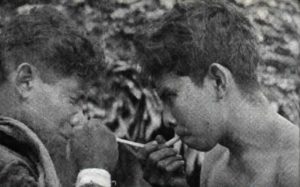
Rapé tools and accessories
There are two tools used to apply and receieve rapé. The kuripe is for self application and the tepi is for partner application. Each of the tribes have their own similar names for these tools, however the names most commonly used outside of native communities comes from the Yawanawa terminology due to their contact with outsiders and sharing of shamanic practices and knowledge in Brazil.
A very important component about traditional rapé usage is that it should never be snorted, but rather blown into the nose. In Europe when snuffs are used, they are often snorted from a little spoon or container – that is a faux pas to the indigineous people, much alike how tobacco should never be inhaled into the lungs and only ever puffed like a cigar.
Kuripe
The kuripe is for self application. It is also called a “kuripa”. People often also call these “applicators”.
Tepi
The tepi is for partner application, to give rapé to someone else. It is also called a “tipi”. People often also call these “rapé pipes”.
The history of rapé – an innovation out of the Amazon and into the Andes
Here is a very interesting talk on Youtube where we sourced the information:
- primitive people would smoke plant materials
- it was very ineffective to bring these treasures of the jungle up into the high mountain civilizations
- the original plants used were not even tobacco, tobacco snuffs emerged later on as one part of a bigger selection of snuff related products
- it was ineffective
- they invented snuff
- there is a clear archeological timeline of this happening where smoking pipes disappear from the record of artifacts and kuripes and tepis begin to appear
How did snuffs spread from the Americas to Europe?
…
Modern usage of rapé
Today, rapé usage has spread to the modern world.
Ceremonial usage
Many “rapé ceremonies” have started to pop up across urban centers in South & North America, as well as Europe. Generally, people will come to gather for a night where rapé is given to them from a facilitator with a tepi.
Sometimes the facilitator is an indigineous person who travels around the world and offers experiences and ceremonies to those interested, and other times it is simply a local person who uses rapé and wants to build community because they have a deep passion for this or sometimes simply make some money out of it. Sometimes it can be used in conjunction with kambo sessions with sananga too.
In urban centers, in Peru and Brazil especially, there are often many communities centered around shamanic activities so rapé and other ceremonies are present there, where native people (and those from modern society who have trained in their lineage) will facilitate workshops and ceremonies.
Casual and personal usage
It has also spread into casual use, where people will use rapé themselves in their daily lives or even casually and socially. While some people scorn this usage, it is not uncommon for some tribes in South America to also casually use rapé in the same way that a group of people might sit around and casually share a couple drinks or coffee together.
I cannot speak for everyone, but when asked why people use rapé, they often will mention how it grounds them and gives them clarity and focus. Other people will say how they simple enjoy it.
Rapé terminology
Haux
Haux, pronounced “how-sh”, is a term used by natives. It has many meetings, such as a greeting, a celebratory statement like “hallelujah” or “viva”. “Haux haux” is often said in the process of applying and consuming rapé, as a greeting to the spirit world, or in every day speech.
It is believed that “haux” was first said at the time of the creation
Txai
Txai, pronounced “chai” like the tea, is a friendly term for your buddy that you do rapé with.
Traditional usage by Indigineous Peoples of the Amazon in South America
In the section we highlight a couple of the many different tribes who use different Shamanic Snuffs. There are countless different tribes who consume shamanic snuffs all over South America and by no means is our article able to cover them all.
If you are very interested in this topic, we suggest you read the book “Shamanic Snuffs Or Entheogenic Errhines” by Jonathan Ott.
Haux haux!
Yawanawa
Being a populous and well known tribe, the influence of many Yanawaná blends has reached the west.
Historically, the Yawanawa tribe received rapé soon after a famous healer of their tribe died. The tribe believes that this sacrament arose to cure diseases of the mind, psyche, and body, by enhancing the connection with one’s spirit and enabling them to travel without their physical bodies. Their rapé tradition is very old, and in earlier times, only the medicine man of the tribe – the pajeh – was allowed to take rapé and connect with the forest spirits. Nowadays, all tribe members can take rapé freely and for certain ceremonies and rites.

The Yawanawa use the word “Rume” (hoo-me) or “Ruma” (hoo-ma) for their rapé. It primarily contains ash of the bark of the Txunú tree and a strong tobacco similar to mapacho making it unique and signature. The txunú tree bark is often used for healing and curing purposes in Amazonian tribes and has a supportive role during ayahuasca ceremonies. It is often used before ayahuasca, enhancing the effects and opening the spirit for the ceremony, but also during intense ceremonial experiences, easing the vomiting and cleaning.
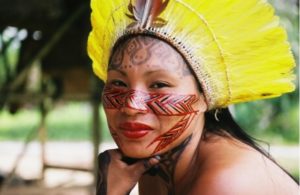
Often only men were allowed to snuff rapé (Wilbert 1987 – Tobacco and Shamanism in South America. Yale University Press, New Haven, CT.). The Yawanawá were the first tribe that initiated a woman to become a shaman. The first female shaman, Hushahu Yawanawá, set a huge example in the history of shamans and even received a national award for outstanding women leaders of Brazil, thereby motivating other women to become shamans. Nowadays, the revolutionist Hushahu is amongst the most respected spiritual leaders of the Yawanawá tribe. Moreover, this daring woman is well-known for making one of the best rapé snuffs of the tribe.
Huni Kuin / Kaxinawá
The proper name for this tribe is the Huni Kuin, which means “true people” or “people with traditions”. Their other name, “Kaxinawá” (ka-sheen-ah-waa), means “cannibals”, “bat people” and “people who walk about at night”. It is still widespread in literature, yet the Huni Kuin reject the name as an insult. The photos here sourced by Sarita Mukani.
For the Huni Kuin, rapé is a medicine which connects its users to the energy of Youshibu (God of Creation). It should be used with respect, as it is sacred. So where should be used with respect, because it is sacred. Alcohol should absolutely never be used in conjuction with rapé for this reason.
The Huni Kuin place a lot of importance on the “feitor”, or the man who makes the snuffs. The feitor must be someone who has a very high amount of knowledge in botany, and have intimiate understanding on the various parts of every single plant. They place a high importance on blends. Using components from the leaves of one plant, the bark of another, and the flowers of a third and the ashes of a fourth all with a perfect balance and harmony between the components.
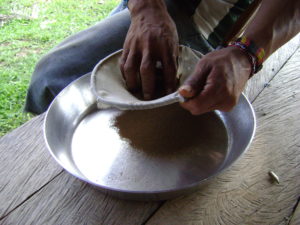
Plants that are frequently used by the Huni Kuin include Pxuri, Murici, Cacao do Mato, Canela de Veio.
The Huni Kuin use an expression “passar rapé”. That is a Portuguese infinitive verb to be conjugated, for example: “I use rapé” > “Eu passo rapé”, “You use rapé” > “Voce passa rapé”. As univesally in the Amazon, the rapé should be blown into both nostrils, if you blow with only one nostril it will result in an unbalance.
The world they use for “kuripe” is “curipa”, and they call the “tepi” a “tipi”.
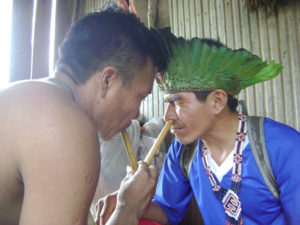
There are various different breaths, or “sopros” that can be used during application of rapé. Two examples are the “yubé” breath and “jiboia” (boa constrictor) breath. There are many other breaths that vary in length and intensity, the breath will determine how long the duration of the force you feel will last: a strong and fast breath will have a very different energetic impact than a long drawn out softer breath.
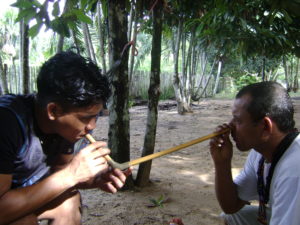
The Huni Kuin use rapé as a cure for physical ailments such as heacache or stuffy nose, and for non-physical ailments like panemas which are ailments of the spirit. They are very attentive that the process of blowing rapé into you is the process of the forest plants entering your body, each with the personality of the individual plant personifying inside of you. They use it in conjunction with their ayahuasca rituals, which they call “nixi pae” (nee-shee pah-ee) where the rapé is used while under the influence of ayahuasca.
Most often times the Huni Kuin will use rapé by itself, while singing songs of healing and shamanism. It brings to use the charms of the forest plants with direct action in our own bodies. Here is some Huni Kuin music for your enjoyment:
The Huni Kuin call the spirit “yuxin” (yoo-sheen), and believe only a true shaman can connect the spirit of the tribe to that of the forest and connect their two realities. However, most of the indigineous believe that there are no real shamans around anymore yet in the future new apprentices may become initiated. “Shaman” is a western word that comes from Europe and Russia, they do not actually have that word in their vocabulary. They believe shamanic initation comes from being guided by the plant kingdom, but at the height of their skills they will be able to work without even needing the plants: being able to connect with the higher worlds using the “yuxin” power alone.
The Huni Kuin wear feathery clothes and paint their entire bodies.
Matsés and Nunu (or Nënë)
The Matsés (also called the Mayoruna meaning “river people”) are known for their signature use of Nunu (or also called Nënë) rapé. In this section I highlight some content that was sourced by Peter Gorman and a full comprehensive collection of his writings on the topic can be sourced in his book “Sapo in my Soul“. We give credit to Amazon Explorer for the photos in this section.
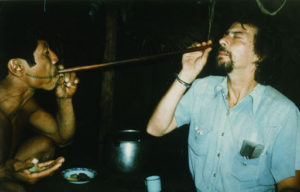
Nunu rapé is considered much more tame than other snuffs of the Amazon. Its primary constituant is the inner bark of the macambo tree – theobroma bicolor, or the inner bark of the cacao tree – theobroma cacao. Oddly enough, the final product turns out into a nice rich dark green color. Sometimes the rapé contains mapacho – nicotiana rustica, however other times it does not depending on which tribe made it.
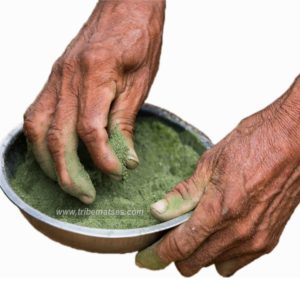
Other names for Nunu rapé are Rapé Verde (green), Nënë, and Asi. It is also made by the Yanawaná tribe, and some others who will actually blend together macambo, cacao, ash, and other plants. Some tribes will make it with aspidosperma subincanum, also called cacahuilo.
The Matsés will traditionally make the snuff with two hunters, who infuse their own spirit into Nunu. In the recipe where tobacco is used, one man will roast the tobacco leaves over a fire, and the other man will collect the tree bark and place it into a pot with hot coals to bring it down into a nice ash. Then these components come together where they are pulverized together and run through cloth. Then it is stored into bottles and corked. It is very vital for preservation that it is kept dry.
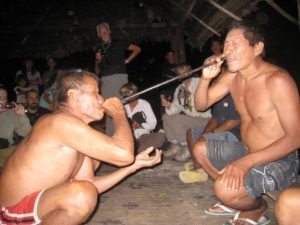
The Matsés will use hollowed out reeds in place of kuripes and tepis. During application of the Nunu, sometimes a man will take up to 15 shots of Nunu in his nose consecutively! Alternating between his nostrils, of course.
Something interesting about the Matsés usage of Nunu is that it is not always ceremonial, and can be used in good spirits for fun at home with your pals. Not everything has to be ceremonial in order to use it with reverence. The tribe will use it after a successful hunt to wind down with the tribe because it gives them a good feeling, but it can also be used as a hunting aid in conjunction with kambo.
The Matsés will use Nunu as a form of divination, where they will receive a hit and look in their mind for the visualizations of what animals to hunt and where they will hunt it. Note that Nunu is not a hallucinogen, and the mental pictures are a form of enhanced imagination rather than some type of psychedelic imagery. In this situation, only a hunter should be giving Nunu to another hunter because the intent is to pass the hunting energy of one hunter into the other.
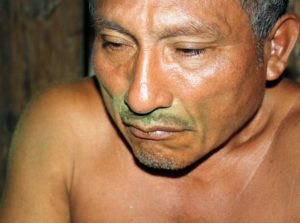
The day after Nunu is administered for hunting, the Matsés will try to go to the place in the jungle that they visualized the animals will be and continue the hunt. It is rumored among the Matsés that when a man consumes Nunu and sees in his mind the animal that he will kill, the animal will also see in its mind a vision of the man killing him!
Syncretically with kambo, Nunu has an interesting use. It is said that a man will take kambo in order to visualize where he should set his trap for an animal to be cought in, and then use the Nunu snuff in order to see when the trap is going to be sprung. In his book Peter Gorman witnessing a correct divination of this nature occuring during his time with the Matsés. The tribespeople will also take Nunu right after the effects of kambo have worn off.
Kuntanawa
The Kuntanawa tribe are a small group of about 400 remaining members, and they call themselves the “coconut people”. The Kuntanawá say that rapé helps them to gain strength, clarity, and power to have the right attitude and to take correct decisions.
Interestingly, their Rapé stimulates the chest and is considered heart opening – as it contains ashes of the Tsunu tree (Platycyamus regnellii). Their rapé usually contains tobacco and a.o. Samauma, Nissural, Jarina, and Sanssara.
The following text is a translated excerpt from an interview with Haru Kuntanawa, the political and spiritual authority of the Kuntanawa tribe:
“Rapé is a purification process brought about by the plants. Rapé helps us to remove unwanted things from ourselves, diseases in the form of panema [a type of spiritual illness], things that do not belong to us humans but that we end up taking on through certain experiences. Rapé has the ability to strengthen the spirit of everything. The blow (of rapé) and breath is sacred. Breath is life. But the blow depends a lot on the person serving the rapé.”
For your enjoyment we included a video below of Haru Kuntanawa playing some music:
Katukina
The Katukina tribe …
Shawadawa
The Shanenawa tribe …
Puyanawa
The Puyanawa tribe are known for their facial tattoos. They have nuclear families where each one owns a plot of land used for farming personal amounts of food such is manioc, maize, beans, mudubim, rice, bananas, lourinho, and arigó. They live close to Cruzeiro do Sul, Acre and make blends with their locally farmed plant ingredients. Their blends often use very little ash, but when they do it is from the jagube vine.
Nukini
In the Nukini tribe, women are the ones who collect plants and make rapé. Their signature blends tend to be very dry, and often contain roses, eucalytpus, parika, tobacco, and “mulatinha”. They also work with a plant called “trevo cumaru” which is not the same as the “cumaru” of the tonka beans, and the herb that smells like vanilla which is an agent to help treat coughs, bronchitis, asthma and respiratory problems.
Apurina
Apurina people speak Maipure-Aruak and call themselves ‘Popingaré’ or ‘Kangite’, meaning ‘people’ or ‘humans’. Female tribe members are skilled at making baskets, brooms, and pottery, and also beautiful rapé off snail, metal, and rubber residues.
The Apurina people value their rituals which are called Xingané (shin-gah-neh). These celebrations start with a ceremonial “armed confrontation” between the hosts and guests, where the leaders of each party will take rapé from eachothers hands.
They use “gray” rapé, which is more ash-heavy and has a gray appearance. All of their botanical components that are not ash are always raw, and never fermented or cooked. They preserve a secret flowery recipe which they do not share with outsiders.
Arara
The Arara tribe are very distant from the modern world. The belong to the Shawndawa tribe and live around the city Cruzeiro do Sul in Acre, Brazil. They comprise of about 1000 members and lost their native language which is very similar to that of the Yawanawa, with only about 4 remaining native speakers.
Their signature rapé is made from “Sanu”, which is their word for Tsunu.
Puyanawa
The Puyanawa tribe …
Shanewana
The Shawenawa tribe …
Conclusion and notes
If you have more knowledge on the subject we are happy for you to send us your contributions through the contact form on our website. Thank you.
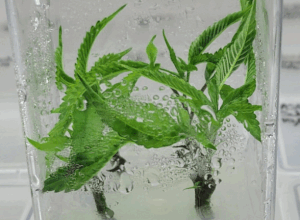
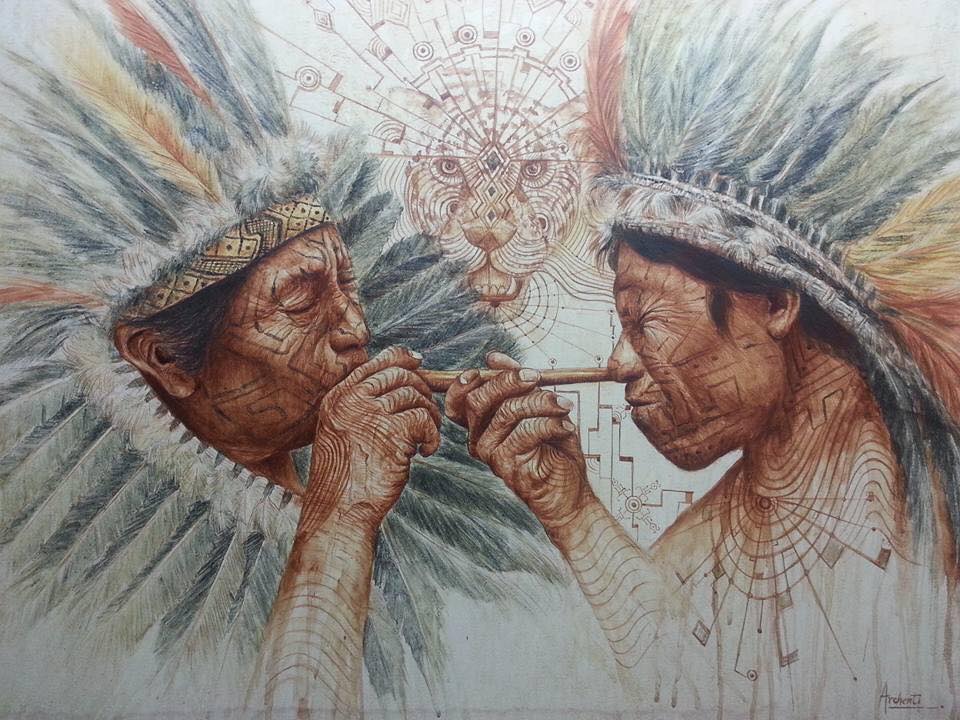
Hapeh has become part of my daily life. I begin every morning with a personal hapeh ceremony. It brings me grounding, clarity and often downloads of great value.
I am looking to find a person to study with to learn more about hapeh and how best to serve it to others. Can you point me to someone with whom I can study?